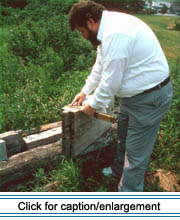|
 During
the summer of 1991, the American Folklife Center, Library of Congress,
conducted a survey of Maine Acadian culture through an inter-agency agreement
with the National Park Service. Folklife fieldworkers designed a fieldwork
strategy for the documentation of the contemporary culture of the Upper
St. John Valley with emphasis on Acadian cultural resources. While tailored
to deal with issues unique to the Valley, this data collection strategy
was broadly similar to those employed by other folklife field projects.
Fieldworkers concentrated their efforts on cultural expressions, guided
by the idea that all communities use aesthetic experience to shape deeply
felt values into meaningful forms (Hymes 1975: 348). These expressions,
such as stories, songs, recipes, and houses, which have grown out of shared
experiences and values, can serve as windows into a community's worldview
(Hufford 1986: 19). During
the summer of 1991, the American Folklife Center, Library of Congress,
conducted a survey of Maine Acadian culture through an inter-agency agreement
with the National Park Service. Folklife fieldworkers designed a fieldwork
strategy for the documentation of the contemporary culture of the Upper
St. John Valley with emphasis on Acadian cultural resources. While tailored
to deal with issues unique to the Valley, this data collection strategy
was broadly similar to those employed by other folklife field projects.
Fieldworkers concentrated their efforts on cultural expressions, guided
by the idea that all communities use aesthetic experience to shape deeply
felt values into meaningful forms (Hymes 1975: 348). These expressions,
such as stories, songs, recipes, and houses, which have grown out of shared
experiences and values, can serve as windows into a community's worldview
(Hufford 1986: 19).
The primary work of the survey's fieldworkers was interviewing local
residents, documenting cultural events, documenting sites and artifacts,
engaging in participant observation, and analyzing archival materials.
The report of the survey fieldworkers (Brassieur 1992) formed the basis
for the 1992 public review draft of this volume.
 The survey aggregated a large ethnographic collection consisting of 5,600
photographic images, 500 pages of field notes and catalogs, 40 hours of
audio recordings, 50 pages of sketches, and an assortment of ephemera
such as local publications, program souvenirs, and historical and contemporary
press clippings on cultural subjects and issues. The collection will be
preserved for posterity in the Archive of Folk Culture, Library of Congress.
A reference copy has been placed at the Acadian Archives/Archives acadiennes
where it will serve as a resource for further research, planning, and
programming within the region.
The survey aggregated a large ethnographic collection consisting of 5,600
photographic images, 500 pages of field notes and catalogs, 40 hours of
audio recordings, 50 pages of sketches, and an assortment of ephemera
such as local publications, program souvenirs, and historical and contemporary
press clippings on cultural subjects and issues. The collection will be
preserved for posterity in the Archive of Folk Culture, Library of Congress.
A reference copy has been placed at the Acadian Archives/Archives acadiennes
where it will serve as a resource for further research, planning, and
programming within the region.
|
 |
 |
 As
part of the folklife survey, data was collected relative to eight Acadian
houses: Maison Heritage and the Val Violette House in Van Buren, Maine;
the Morneault House, originally in Grand Isle, Maine; the Fred Albert
House and the Ernest Chasse House in Madawaska, Maine; the Pelletier-Marquis
House in St. Agatha, Maine; the Eloi Daigle House in Fort Kent, Maine;
and the Daigle-St. Jean House in Clair, New Brunswick. For each of these
properties, the survey collected information about the succession of ownership,
the family history and genealogy of residents, and the business and civic
dealings of the owners. Several of these houses are now owned by local
historical societies, and others remain in private ownership. Several
hundred transactions were reviewed utilizing various land and family records.
Charts showing the succession of ownership and genealogies of most associated
families were prepared. In addition, a glossary of Maine Acadian French
terms related to vernacular architecture and cultural landscape was compiled.
It provides a point of entry for understanding a range of material culture
features both inside and outside the study area. As
part of the folklife survey, data was collected relative to eight Acadian
houses: Maison Heritage and the Val Violette House in Van Buren, Maine;
the Morneault House, originally in Grand Isle, Maine; the Fred Albert
House and the Ernest Chasse House in Madawaska, Maine; the Pelletier-Marquis
House in St. Agatha, Maine; the Eloi Daigle House in Fort Kent, Maine;
and the Daigle-St. Jean House in Clair, New Brunswick. For each of these
properties, the survey collected information about the succession of ownership,
the family history and genealogy of residents, and the business and civic
dealings of the owners. Several of these houses are now owned by local
historical societies, and others remain in private ownership. Several
hundred transactions were reviewed utilizing various land and family records.
Charts showing the succession of ownership and genealogies of most associated
families were prepared. In addition, a glossary of Maine Acadian French
terms related to vernacular architecture and cultural landscape was compiled.
It provides a point of entry for understanding a range of material culture
features both inside and outside the study area.
|
|

